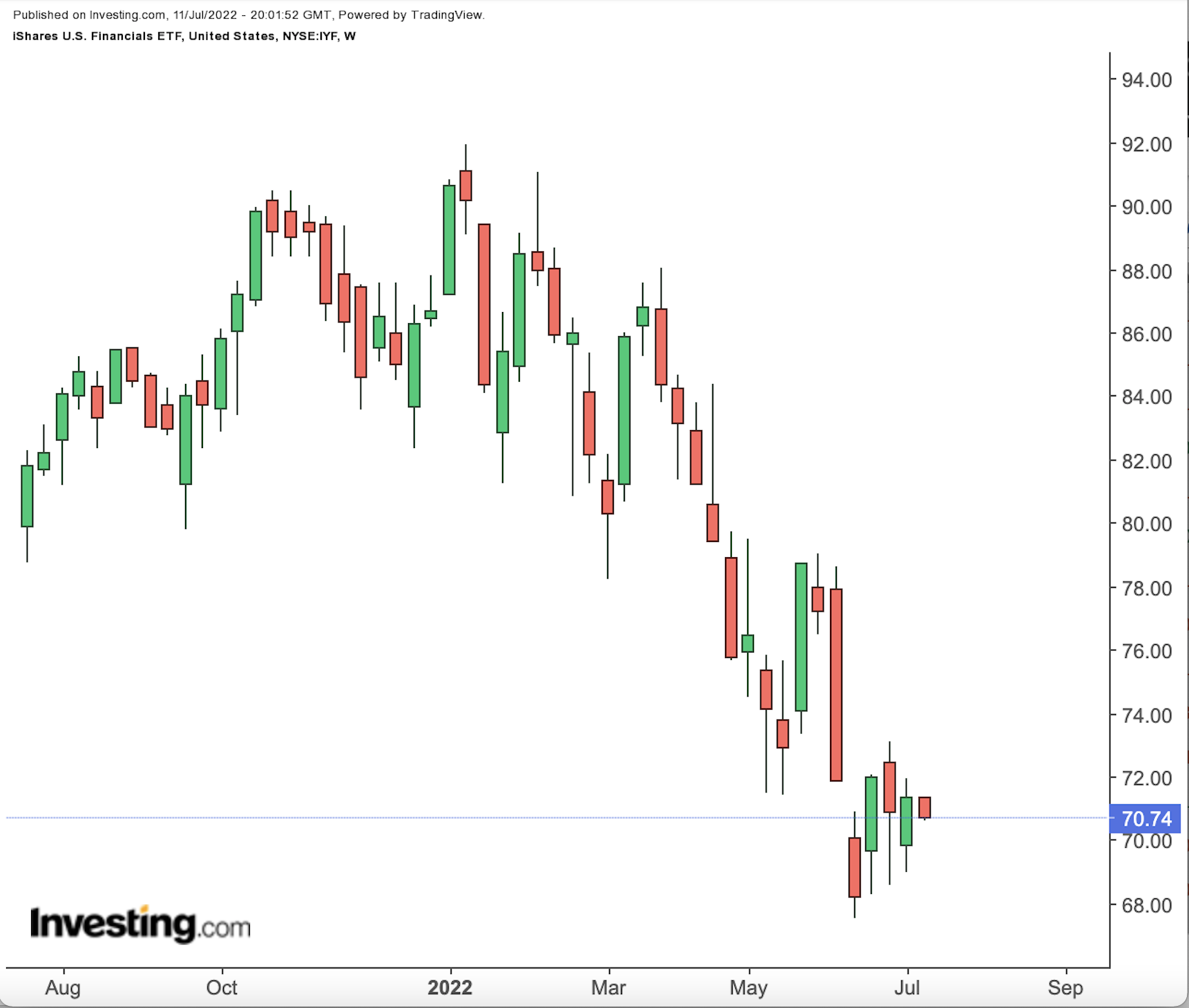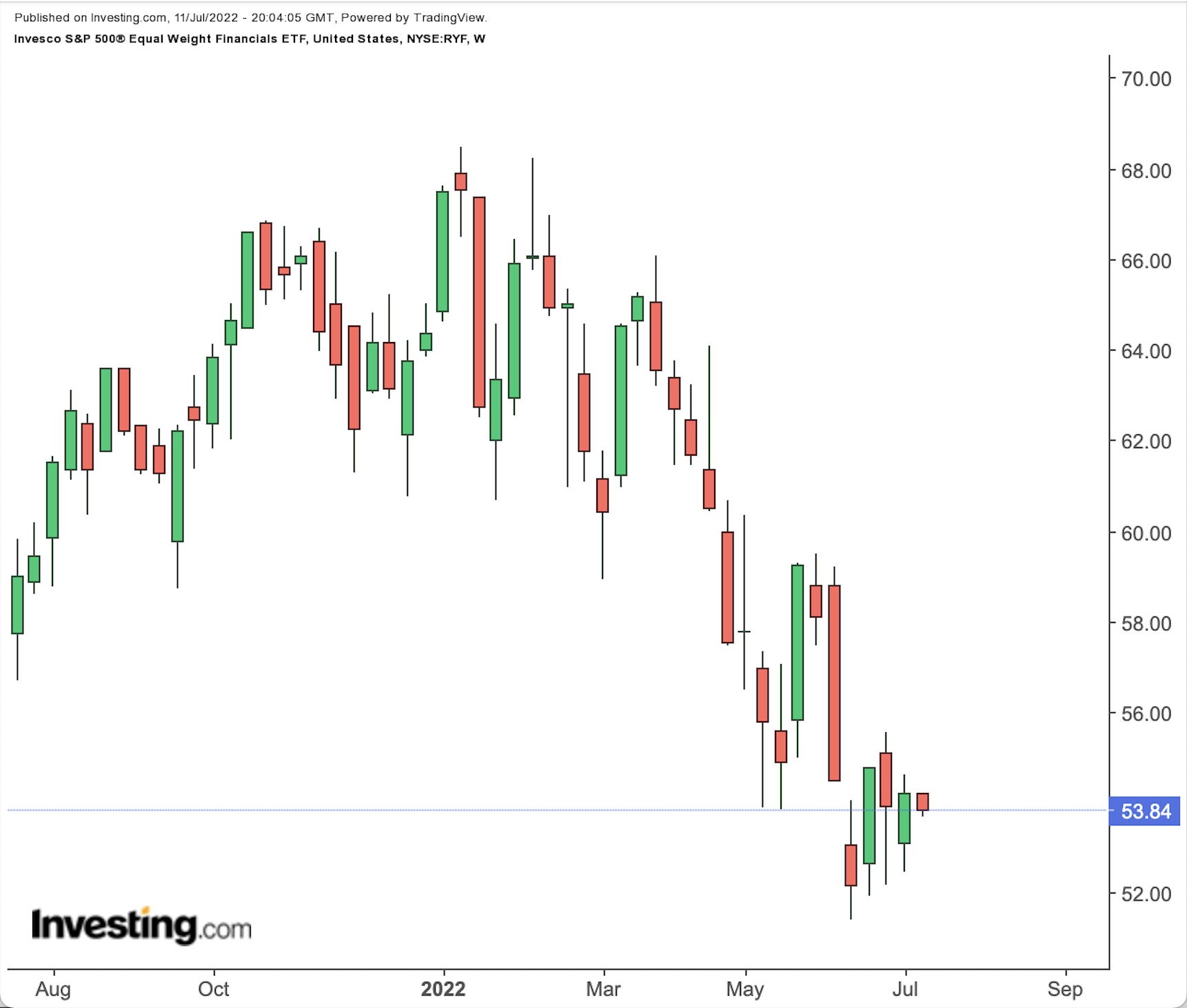- Recent declines in financial shares make industry ETFs attractive this earnings season
- Wall Street will be analyzing metrics from JP Morgan Chase and Morgan Stanley due on July 14
- Financial sector ETFs like IYF and RYF offer value in long term
Bank stocks and exchange-traded funds (ETFs) that invest in them have come under significant pressure. Mounting fears of a global recession and skyrocketing inflation continue to take their toll on financial services stocks.
Investors have been shying away from many names, especially in banking and insurance segments, fearful of the financial industry’s poor returns during recessions. For instance, the S&P 500 Banks Industry Group Index and the KBW Bank Index have fallen about 24.5% and 22.5%, respectively, so far this year. By comparison, the S&P 500 has dropped 19.2% over the same period.
With the second-quarter earnings season right around the corner, major players JP Morgan Chase (NYSE:JPM) and Morgan Stanley (NYSE:MS) will be among the earliest to report. Wall Street will pay close attention to their metrics due on July 14.
Analysts are debating what to expect from the financial sector, especially the big banks. A major concern is the excessive optimism still present in earnings forecasts. As Reuters recently reported:
“There have been very few downward revisions of corporate earnings, there's still too much optimism. That's why we expect another correction when earnings are published. And with this volatility, one really risks taking a beating.”
Despite these significant challenges, other analysts suggest many bank stocks could be near a bottom. Fundamental valuation also offers investors solid hope for future months.
For example, according to a number of valuation models, like those that might consider P/E or P/S multiples or terminal values, the average fair value for JPM and MS stocks on InvestingPro suggest an upside potential of about 31% and 22%, respectively, for these shares. Therefore, many financial names could be positioned for a dramatic rebound in the future.
With that information, here are two bank ETFs to consider in Q3.
1. iShares U.S. Financials ETF
Current Price: $70.77
52-Week Range: $67.51 - $91.95
Dividend Yield: 1.79%
Expense Ratio: 0.41% per year
The iShares U.S. Financials ETF (NYSE:IYF) gives access to the financial industry in the U.S. It invests mainly in shares of banks, insurance holdings as well as credit card companies. The fund started trading in May 2002 and net assets are around $1.9 billion.

Source: Investing.com
IYF, which tracks the Dow Jones U.S. Financials Capped Index, currently holds 140 stocks. Around 40% of the portfolio is in the top 10 names, making it a top-heavy ETF. This means that during the earnings season, the performance of one of these leading stocks could affect the fund, especially in the short run.
Warren Buffett’s Berkshire Hathaway (NYSE:BRKa) (NYSE:BRKb), JPMorgan Chase, Bank of America (NYSE:BAC), Wells Fargo (NYSE:WFC), and S&P Global (NYSE:SPGI) are among the most prominent financial names in the fund. In terms of sub-sectors, diversified financials have the largest slice with 43.59%, followed by banks (32.73%), and insurance (22.87%).
IYF hit a record in January, but lost more than 18% YTD. Trailing price-to-earnings (P/E) and price-to-book (P/B) ratios are at 9.37x and 1.44x. Readers whose risk/return profiles allow for short-term volatility could find value in IYF around these levels.
2. Invesco S&P 500 Equal Weight Financials ETF
Current Price: $53.83
52-Week Range: $51.40 - $68.49
Dividend Yield: 2.03%
Expense Ratio: 0.4% per year
The Invesco S&P 500® Equal Weight Financials ETF (NYSE:RYF) is an equally-weighted fund that invests in a broad range of U.S. financial shares. The ETF was first listed in November 2006, and has $434.7 million under management.

Source: Investing.com
RYF, which has 67 holdings, tracks the returns of the S&P 500 Equal Weight Financials Index. Insurance stocks have the highest weighting with 32.81%. The fund also includes stocks from the capital markets (31.32%), banks (26.06%), and consumer finance (5.67%).
The top 10 stocks comprise close to 17% of the portfolio. Member names include financial data and analytics company Factset Research Systems (NYSE:FDS), risk management group Aon (NYSE:AON), insurance companies Arthur J Gallagher & Co (NYSE:AJG) and Brown & Brown Inc (NYSE:BRO), and leading exchange and clearinghouse Cboe Global Markets (NYSE:CBOE).
Like the previous fund, RYF also saw an all-time high in January, but lost more than 16% in 2022. Trailing P/E and P/B ratios stand at 10.81x and 1.65x. Investors looking for increased and equal-weight exposure to names other than the leading U.S. banks may consider investing around these levels.
Disclosure: Tezcan Gecgil, Ph.D., does not hold positions in either IYF or RYF.
